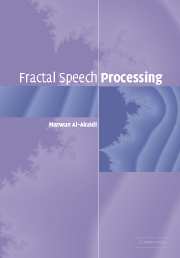Book contents
- Frontmatter
- Contents
- List of acronyms and abbreviations
- 1 Introduction to speech processing
- 2 Computational background
- 3 Statistical analysis, entropy and Bayesian estimation
- 4 Introduction to fractal geometry
- 5 Application to speech processing and synthesis
- 6 Speech processing with fractals
- 7 Speech synthesis using fractals
- 8 Cryptology and chaos
- Index
4 - Introduction to fractal geometry
- Frontmatter
- Contents
- List of acronyms and abbreviations
- 1 Introduction to speech processing
- 2 Computational background
- 3 Statistical analysis, entropy and Bayesian estimation
- 4 Introduction to fractal geometry
- 5 Application to speech processing and synthesis
- 6 Speech processing with fractals
- 7 Speech synthesis using fractals
- 8 Cryptology and chaos
- Index
Summary
In this chapter we investigate the use of fractal geometry for segmenting digital signals and images. A method of texture segmentation is introduced that is based on the fractal dimension. Using this approach, variations in texture across a signal or image can be characterized in terms of variations in the fractal dimension. By analysing the spatial fluctuations in-fractal dimension obtained using a conventional moving-window approach, a digital signal or image can be texture segmented; this is the principle of fractal-dimension segmentation (FDS). In this book, we apply this form of texture segmentation to isolated speech signals.
An overview of methods for computing the fractal dimension is presented, focusing on an approach that makes use of the characteristic power spectral density function (PSDF) of a random scaling fractal (RSF) signal. A more general model for the PSDF of a stochastic signal is then introduced and discussed with reference to texture segmentation.
We shall apply fractal-dimension segmentation to a number of different speech signals and discuss the results for isolated words and the components (e.g. fricatives) from which these words are composed. In particular, it will be shown that by pre-filtering speech signals with a low-pass filter of the form 1/k, they can be classified into fractal dimensions that lie within the correct range, i.e. [1, 2]. This provides confidence in the approach to speech segmentation considered in this book and, in principle, allows a template-matching scheme to be designed that is based exclusively on FDS.
- Type
- Chapter
- Information
- Fractal Speech Processing , pp. 88 - 126Publisher: Cambridge University PressPrint publication year: 2004



